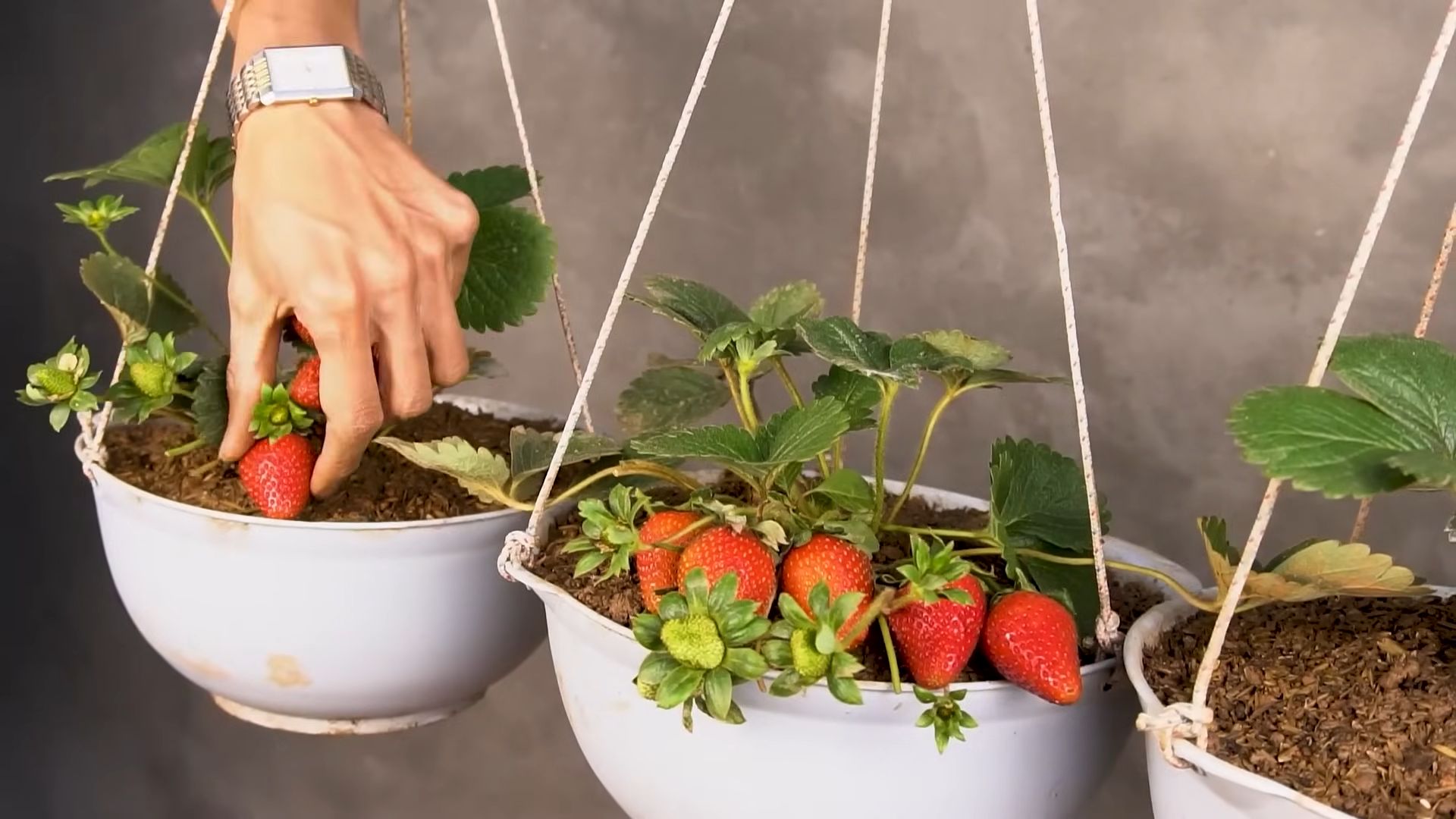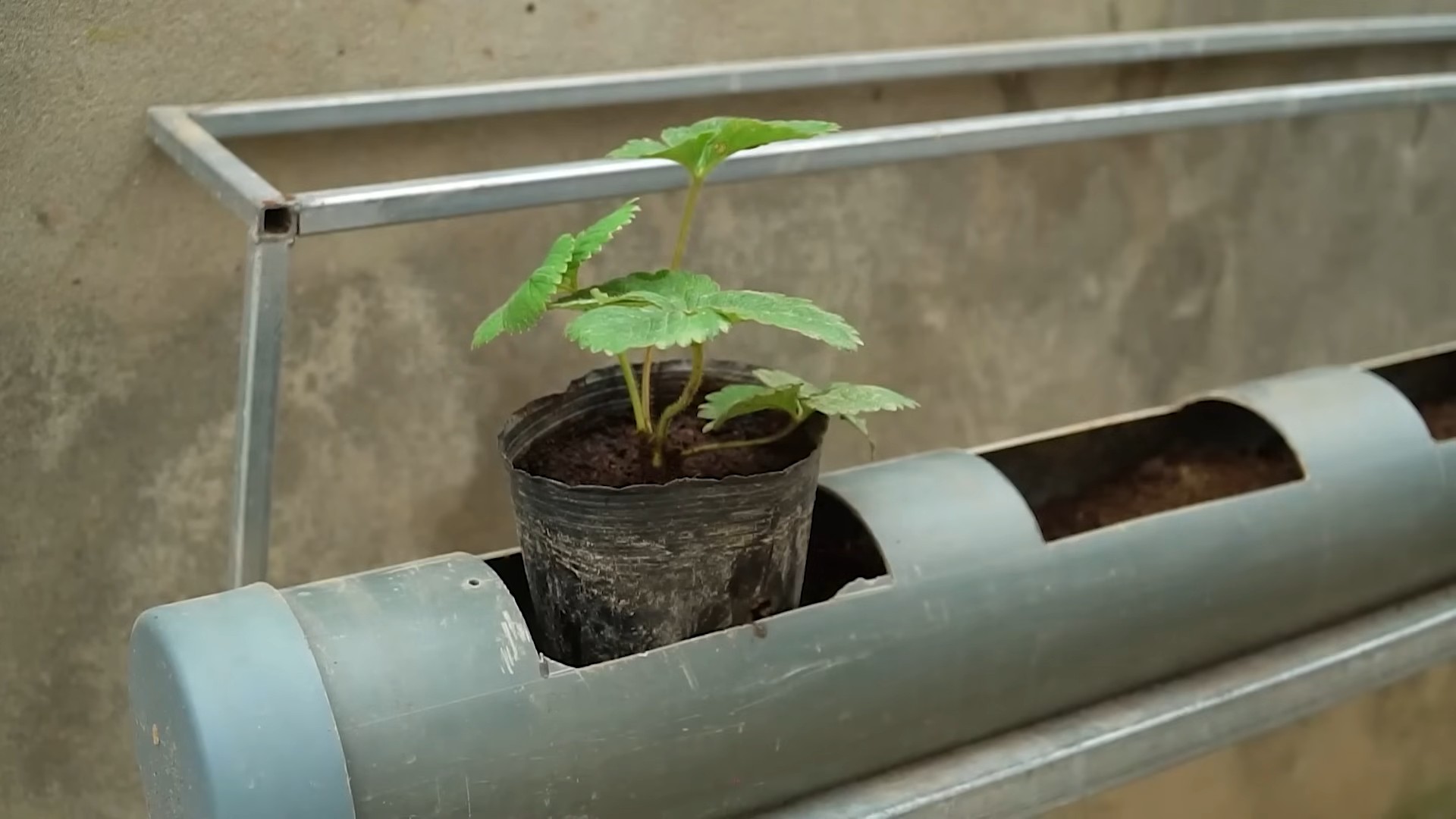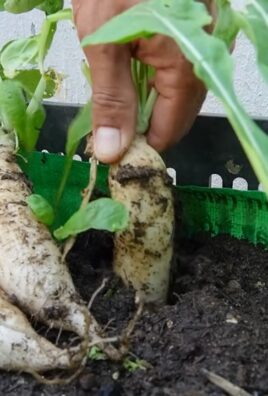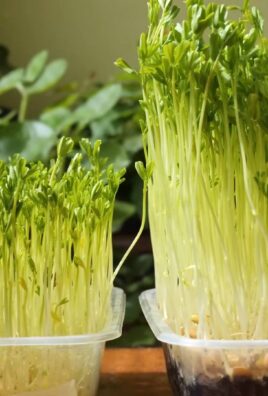Grow Strawberries at Home, imagine plucking juicy, sun-ripened strawberries straight from your own garden! It’s a dream many of us share, and it’s surprisingly achievable, even if you don’t have acres of land. For centuries, cultivating strawberries has been a cherished tradition, dating back to ancient Rome where wild strawberries were enjoyed. In medieval Europe, they were even symbols of perfection and righteousness! Today, the desire to connect with nature and enjoy fresh, healthy produce has fueled a resurgence in home gardening, and strawberries are a perfect place to start.
But let’s be honest, sometimes gardening feels intimidating. That’s where simple DIY tricks and hacks come in! I’m here to share some easy and effective methods to help you grow strawberries at home successfully, regardless of your experience level. Whether you’re dealing with limited space, pesky pests, or just want to maximize your yield, these tips will empower you to create a thriving strawberry patch. Get ready to enjoy the sweet taste of success – and delicious homemade strawberry shortcake!

Grow Your Own Delicious Strawberries: A DIY Guide
Hey there, fellow gardening enthusiasts! Ever dreamt of plucking juicy, sun-ripened strawberries straight from your own backyard? Well, dream no more! Growing strawberries at home is surprisingly easy and incredibly rewarding. I’m going to walk you through everything you need to know to cultivate your own strawberry patch, even if you’re a complete beginner. Let’s get started!
Choosing the Right Strawberry Variety
Before we dive into the nitty-gritty, let’s talk about strawberry varieties. There are three main types, and the best one for you depends on your climate and how you want to harvest your berries:
* **June-Bearing:** These strawberries produce one large crop, usually in late spring or early summer (hence the name!). They’re great if you want to make a big batch of jam or freeze a bunch for later.
* **Everbearing:** Don’t let the name fool you; everbearing strawberries don’t produce fruit continuously. Instead, they have two or three harvests throughout the growing season – one in spring, one in late summer, and sometimes another in the fall.
* **Day-Neutral:** These are the most consistent producers, yielding fruit throughout the growing season as long as the temperature is between 35°F and 85°F. They’re perfect for a steady supply of fresh berries.
Consider your local climate and desired harvest schedule when choosing your strawberry variety. I personally love day-neutral varieties because I enjoy having fresh strawberries all summer long.
Preparing Your Strawberry Bed
Strawberries need a sunny spot and well-drained soil to thrive. Here’s how to get your garden bed ready:
1. **Choose a Sunny Location:** Strawberries need at least 6-8 hours of direct sunlight per day. Pick a spot in your yard that gets plenty of sunshine.
2. **Test Your Soil:** Strawberries prefer slightly acidic soil with a pH between 5.5 and 6.8. You can buy a soil testing kit at most garden centers or send a sample to your local agricultural extension office.
3. **Amend the Soil:** If your soil is heavy clay or sandy, you’ll need to amend it with organic matter like compost, well-rotted manure, or peat moss. This will improve drainage and provide essential nutrients.
* Dig a hole about 12 inches deep and wide.
* Mix equal parts of your existing soil with the organic matter.
* Fill the hole back in, creating a raised bed if possible. Raised beds improve drainage and warm up faster in the spring.
4. **Remove Weeds:** Strawberries don’t compete well with weeds, so it’s important to remove all weeds from your planting area before you plant. You can do this by hand-pulling or using a hoe.
5. **Fertilize:** Before planting, incorporate a slow-release fertilizer into the soil. Look for a fertilizer that’s specifically formulated for berries or vegetables. Follow the instructions on the package for application rates.
Planting Your Strawberry Plants
Now for the fun part – planting your strawberry plants!
1. **Choose Your Planting Method:** You can plant strawberries in the ground, in raised beds, or in containers. I’ve had success with all three methods, but raised beds are my personal favorite.
2. **Space Your Plants:** The spacing depends on the variety you’re planting. June-bearing strawberries need more space than everbearing or day-neutral varieties.
* June-bearing: Space plants 18-24 inches apart in rows that are 3-4 feet apart.
* Everbearing and Day-Neutral: Space plants 12 inches apart in rows that are 2-3 feet apart.
3. **Planting Bare-Root Strawberries:** If you’re planting bare-root strawberries (plants that are sold without soil), soak the roots in water for about an hour before planting.
* Dig a hole that’s large enough to accommodate the roots without crowding them.
* Mound the soil in the center of the hole.
* Place the plant on the mound, spreading the roots out around it.
* Make sure the crown of the plant (the point where the roots meet the stem) is level with the soil surface.
* Fill the hole with soil and gently firm it around the plant.
* Water thoroughly.
4. **Planting Potted Strawberries:** If you’re planting strawberries that are already growing in pots, gently remove the plant from the pot and loosen the roots.
* Dig a hole that’s slightly larger than the pot.
* Place the plant in the hole, making sure the top of the root ball is level with the soil surface.
* Fill the hole with soil and gently firm it around the plant.
* Water thoroughly.
5. **Mulch:** After planting, mulch around your strawberry plants with straw, pine needles, or wood chips. Mulch helps to retain moisture, suppress weeds, and keep the berries clean.
Caring for Your Strawberry Plants
Once your strawberry plants are in the ground, it’s important to provide them with the care they need to thrive.
1. **Watering:** Strawberries need consistent moisture, especially during fruit production. Water deeply whenever the top inch of soil feels dry. Avoid overhead watering, as this can promote fungal diseases. Drip irrigation is the best way to water strawberries.
2. **Fertilizing:** Fertilize your strawberry plants every 4-6 weeks with a balanced fertilizer. Follow the instructions on the package for application rates.
3. **Weeding:** Keep your strawberry bed free of weeds. Weeds compete with strawberries for nutrients and water.
4. **Pest and Disease Control:** Strawberries can be susceptible to a variety of pests and diseases. Monitor your plants regularly and take action if you notice any problems.
* **Slugs and Snails:** These pests can damage strawberry leaves and fruit. You can control them with slug bait or by hand-picking them off the plants.
* **Birds:** Birds love to eat strawberries! Protect your plants with netting or by using bird repellent.
* **Gray Mold:** This fungal disease can cause the berries to rot. Prevent gray mold by providing good air circulation and avoiding overhead watering. Remove any infected berries immediately.
5. **Renovating June-Bearing Strawberries:** After your June-bearing strawberries have finished producing fruit, it’s important to renovate the bed. This involves mowing the plants down to about an inch above the ground and thinning out the runners. Renovation helps to keep the plants healthy and productive.
* Mow the plants down to about an inch above the ground.
* Thin out the runners, leaving only the strongest plants.
* Fertilize the plants with a balanced fertilizer.
* Water thoroughly.
6. **Winter Protection:** In cold climates, strawberries need winter protection. Mulch the plants heavily with straw or pine needles to protect them from freezing temperatures. You can also cover the plants with a row cover.
Harvesting Your Strawberries
The moment you’ve been waiting for – harvesting your strawberries!
1. **When to Harvest:** Strawberries are ready to harvest when they’re fully red and slightly soft to the touch.
2. **How to Harvest:** Gently twist the berry off the plant, leaving the green cap and a short piece of stem attached.
3. **Storage:** Freshly picked strawberries are best eaten right away. If you need to store them, keep them in the refrigerator in a single layer. Don’t wash them until you’re ready to eat them.
Growing Strawberries in Containers
Don’t have a garden? No problem! You can easily grow strawberries in containers.
1. **Choose the Right Container:** Select a container that’s at least 12 inches wide and deep. Make sure it has drainage holes.
2. **Use a Good Quality Potting Mix:** Don’t use garden soil in containers. It’s too heavy and doesn’t drain well. Use a good quality potting mix that’s specifically formulated for containers.
3. **Plant Your Strawberries:** Plant your strawberry plants in the container, following the same spacing guidelines as for planting in the ground.
4. **Water and Fertilize Regularly:** Container-grown strawberries need to be watered and fertilized more frequently than strawberries grown in the ground. Water whenever the top inch of soil feels dry and fertilize every 2-4 weeks with a balanced fertilizer.
5. **Provide Sunlight:** Place your container in a sunny location that gets at least 6-8 hours of direct sunlight per day.
6. **Overwintering:** In cold climates, you’ll need to protect your container-grown strawberries from freezing temperatures. You can move the container to a sheltered location, such as a garage or shed, or you can wrap the container in burlap or bubble wrap.
Troubleshooting Common Strawberry Problems
Even with the best care, you might encounter some problems when growing strawberries. Here are a few common issues and how to address them:
*

Conclusion
So, there you have it! Growing strawberries at home, especially using our simple DIY trick, is not just a gardening project; it’s an investment in fresh, flavorful, and organically grown fruit that you can enjoy right from your backyard or balcony. Forget those bland, store-bought berries that lack the vibrant taste of sunshine and homegrown goodness. This method offers a cost-effective, space-saving, and incredibly rewarding way to cultivate your own strawberry patch.
Why is this DIY approach a must-try? Because it simplifies the process, making it accessible even to beginner gardeners. It maximizes your yield by optimizing space and sunlight exposure. And most importantly, it allows you to control the growing environment, ensuring that your strawberries are free from harmful pesticides and chemicals. Imagine the satisfaction of picking plump, juicy strawberries that you nurtured from start to finish!
But the fun doesn’t stop there! Feel free to experiment with different strawberry varieties to discover your personal favorites. Try alpine strawberries for their intense aroma and everbearing nature, or opt for June-bearing varieties for a bountiful harvest all at once. You can also explore different container options, from repurposed buckets and hanging baskets to tiered planters and vertical gardens. The possibilities are endless!
Consider adding companion plants like basil or marigolds to your strawberry patch. These not only enhance the flavor of your strawberries but also deter pests naturally. Another variation is to use different types of soil mixes to see which one yields the best results in your specific climate and growing conditions. Remember to document your experiments and share your findings with fellow gardeners!
We wholeheartedly encourage you to give this DIY trick a try. It’s a fantastic way to connect with nature, learn new skills, and enjoy the delicious rewards of your labor. Don’t be intimidated if you’ve never grown strawberries before. This method is designed to be simple and straightforward. With a little patience and care, you’ll be harvesting your own sweet treats in no time.
And once you’ve experienced the joy of growing strawberries at home, we’d love to hear about your journey! Share your photos, tips, and experiences in the comments section below. Let’s create a community of strawberry enthusiasts who are passionate about growing their own food and sharing their knowledge with others. Together, we can inspire more people to embrace the joys of gardening and enjoy the unparalleled taste of homegrown strawberries. So, grab your gardening gloves, gather your supplies, and get ready to embark on a delicious adventure!
Frequently Asked Questions (FAQ)
What is the best time of year to plant strawberries?
The ideal time to plant strawberries depends on your climate and the type of strawberries you’re growing. In general, early spring or late fall are the best times to plant. Spring planting allows the plants to establish themselves before the heat of summer, while fall planting gives them a head start for the following spring. For June-bearing varieties, spring planting is often preferred. For everbearing and day-neutral varieties, both spring and fall planting can be successful. Consider your local climate and growing season when making your decision.
What kind of soil is best for growing strawberries?
Strawberries thrive in well-drained, slightly acidic soil with a pH between 5.5 and 6.5. The soil should be rich in organic matter to provide essential nutrients and retain moisture. Amend your soil with compost, aged manure, or other organic materials before planting. Avoid heavy clay soils, as they can lead to root rot. If you have clay soil, consider growing your strawberries in raised beds or containers with a well-draining potting mix. A good soil mix for strawberries is typically composed of equal parts garden soil, compost, and peat moss or coco coir.
How much sunlight do strawberries need?
Strawberries need at least 6-8 hours of direct sunlight per day to produce a bountiful harvest. Choose a location that receives full sun for most of the day. If you live in a hot climate, some afternoon shade can be beneficial to prevent the plants from overheating. Insufficient sunlight can result in smaller berries and reduced yields. Monitor your plants throughout the growing season and adjust their location if necessary to ensure they receive adequate sunlight.
How often should I water my strawberry plants?
Water your strawberry plants regularly, especially during dry periods. The soil should be consistently moist but not waterlogged. Water deeply and thoroughly, allowing the water to penetrate the root zone. Avoid overhead watering, as it can promote fungal diseases. Instead, water at the base of the plants using a soaker hose or drip irrigation system. Check the soil moisture regularly and adjust your watering schedule accordingly. During hot weather, you may need to water more frequently.
How do I fertilize my strawberry plants?
Fertilize your strawberry plants in early spring and again after the first harvest. Use a balanced fertilizer specifically formulated for berries, or a general-purpose fertilizer with an NPK ratio of 10-10-10. Follow the instructions on the fertilizer package carefully. Avoid over-fertilizing, as it can lead to excessive foliage growth and reduced fruit production. You can also amend the soil with compost or aged manure to provide a slow-release source of nutrients. Organic fertilizers, such as fish emulsion or seaweed extract, are also excellent options.
How do I protect my strawberries from pests and diseases?
To protect your strawberries from pests and diseases, practice good garden hygiene. Remove any dead or diseased leaves and debris from around the plants. Use row covers or netting to protect the berries from birds and other animals. Monitor your plants regularly for signs of pests, such as aphids, spider mites, and slugs. Treat infestations promptly with insecticidal soap or other appropriate treatments. To prevent fungal diseases, ensure good air circulation around the plants and avoid overhead watering. Consider using organic fungicides if necessary.
How do I propagate strawberry plants?
Strawberries can be propagated through runners, which are horizontal stems that grow from the mother plant. These runners will develop roots and form new plantlets. To propagate strawberries, simply allow the runners to root in the soil or in small pots filled with potting mix. Once the plantlets have developed a strong root system, you can sever them from the mother plant and transplant them to a new location. This is a simple and effective way to expand your strawberry patch.
Can I grow strawberries in containers?
Yes, strawberries are well-suited for container gardening. Choose containers that are at least 12 inches deep and wide to provide ample space for the roots to grow. Use a well-draining potting mix and ensure that the containers have drainage holes. Place the containers in a sunny location and water regularly. Container-grown strawberries may require more frequent watering and fertilization than those grown in the ground. Consider using self-watering containers to simplify the watering process.
How long does it take for strawberries to produce fruit?
The time it takes for strawberries to produce fruit depends on the variety and the growing conditions. June-bearing varieties typically produce fruit in the spring, about 4-6 weeks after flowering. Everbearing and day-neutral varieties will produce fruit throughout the growing season, with peak harvests in the spring and fall. Be patient and provide your plants with the care they need, and you’ll be rewarded with a delicious harvest of homegrown strawberries.




Leave a Comment